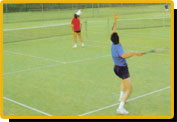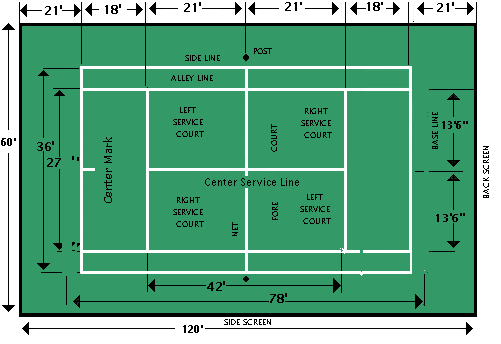The modern version of the game is virtually indistinguishable from the 16th century version, indeed the actual court that Charles I built at Hampton Court in 1625, is still used for cham pionship play today. Visitors to Hampton Court Palace can view the Real Tennis court.The 16th and 17th centuries were a golden age for Real Tennis, it was played by the nobility throughout England and France.In the mid 19th century there was a revival of the game and a flurry of court construction, primarily as additions to estates, most of the courts in use today are products of this period. The first courts in the USA and Australia were built in 1876 and 1882 respectively. pionship play today. Visitors to Hampton Court Palace can view the Real Tennis court.The 16th and 17th centuries were a golden age for Real Tennis, it was played by the nobility throughout England and France.In the mid 19th century there was a revival of the game and a flurry of court construction, primarily as additions to estates, most of the courts in use today are products of this period. The first courts in the USA and Australia were built in 1876 and 1882 respectively.
Rule 1. Opponents stand on opposite sides of the court. The player who delivers the ball to start the point is called the server. The player who stands opposite and cross-court from the server is the receiver.Rule 2. The right to serve, receive, choose your side, or give the opponent these choices is decided by a toss of a coin or racquet. If the choice of service or receiver is chosen, the opponent chooses which side to start. Rule 3. The server shall stand behind the baseline on the deuce court within the boundaries of the singles court when playing singles and within the doubles sideline when playing doubles. See court dimensions. All even points are played from the deuce court and odd number points played from the advantage court. The server shall not serve until the receiver is ready. Serves are made from the deuce court to the opponents service box on the deuce court. Advantage court to advantage box. If the server misses his target twice, he loses the point. If the ball hits the net and goes in the correct service box, another serve is granted. If the server steps on the baseline before contact is made, the serve is deemed a fault. Rule 4. The receiver is deemed ready if an attempt is made to return the server’s ball. The receiver can stand where he likes but must let the ball bounce in the service box. If the ball does not land in the service box, it is deemed a fault and a second serve is given. If the ball is hit by either opponent before the ball bounces, the server wins the point. Rule 5. The server always calls his score first. If the server wins the first point, he gets a score of 15. Scoring is done like a clock. See example below. Love means zero in tennis. The second point is called 30. The third point is called 45 (now-a-days known as 40) and game is won when the score goes back to love. If the score is 40-40, also known as deuce, one side must win by two points. Advantage-In means if the server wins the next point, he wins the game. Advantage-Out means the receiver has a chance to win the game on the next point. LOVE 15-30-40 Rule 6. After the game, the opponents serve. Games equal 1. The first to win 6 games, by two, wins the set. The first to win 2 sets wins the match. If the score is 6-6, a tie-breaker is played. This is scored by one’s. The first team to score 7 points winning by two wins the set. The tiebreaker continues until one side wins by two. Hence, Game-Set-Match. Rule 7. If the ball goes into the net, or outside the boundaries of the court, the player who hit that ball loses the point. If the ball hits the net during the point and goes into the opponents court, the ball is in play. A player loses the point if he touches the net, drops his racquet while hitting the ball, bounces the ball over the net, hits a part of the surroundings such as the roof, or a tree, the ball touches him or his partner, he deliberately tries to distract the opponent. Rule 8. A let is called during the point if a ball rolls on the court or there is a distraction from someone besides the players on the court. Rule 9. A ball that lands on the line is good. Rule 10. If players serve out of turn or serve to the wrong person or court, the point or game will stand and order will be resumed following the point or game.
|
|
